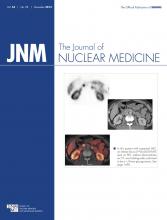Individualizing patient management has been a major development in the field of oncology and has been conceptualized in recent management protocols for differentiated thyroid carcinoma. Dr. Avram, in a lucid review (1), has nicely portrayed the advantages of SPECT/CT over conventional planar imaging. We thank the author for her excellent deliberation and would like to share traditional teachings about planar radioiodine imaging and our own experience with dose decisions and risk stratification in patients with multifocal radioiodine uptake in the neck or upper mediastinum.
At the time of our residency (in a center considered to be the busiest in thyroid cancer management in India), a common teaching was that multifocal uptake in the neck (especially outside the thyroid bed) on preablation scintigraphy would argue for a higher ablative dose of radioiodine than when uptake is confined to a solitary area, as the former likely suggests diseased nodes. This scenario corresponds to cases 2 (Fig. 2) and 3 (Fig. 3) of the review by Dr. Avram. If the foci on radioiodine scintigraphy corresponded to a clinically obvious neck node on palpation or was adjudged sufficiently large by ultrasonography (as mentioned in case 3), the preference would be for surgery before radioiodine therapy, whereas foci that represented a subcentimeter-sized nonpalpable node would be considered for radioiodine ablation upfront. Another common teaching was that after radioiodine ablative therapy, if an abnormal focus was seen in the neck on the 6-mo follow-up 131I scan, its location and pattern required comparison with findings on the preablation and posttherapy scans obtained at the postthyroidectomy visit. If they matched, that would suggest persistent residual neck tissue, whereas if they did not, that would be indicative of a diseased lymph node. This was particularly the case when uptake in the thyroid neck residue merged with uptake in an adjacent node, as corresponds to case 4 (Fig. 4). If this group of patients is treated with a lower ablative dose of 131I, the follow-up scan at 6 mo might demonstrate uptake only in the lymph node, as the residual normal thyroid (being the first filter of administered iodine) would have been ablated by that time. Surgeons commonly prefer not to perform surgery again if the node is subcentimeter-sized on ultrasonography or not clinically palpable and suggest that the referring physician consider radioiodine therapy. As mentioned by Dr. Avram, the prescribed dose for patients in whom unsuspected regional nodal metastases are discovered is 5.5 GBq, compared with 1.1 GBq for patients who have only neck residue.
The scenarios represented by cases 2–4 are common in practice and often are the cause for recurrence or persistence of disease in patients with differentiated thyroid carcinoma. The better lesion delineation and clarification offered by SPECT/CT thus lead to a change in the prescribed radioactivity to higher than the commonly used ablative dose. Many of us now have become quite attuned to interpreting and deciding on these intricacies in planar imaging, but beyond doubt, the better-quality images of SPECT/CT would obviate assumptions and be particularly useful to beginners. We strongly believe that risk stratification in thyroid carcinoma should not be restricted to clinical and histopathologic characteristics alone and that scan patterns (particularly multifocal uptake in a preablation study or an iodine-avid node on a follow-up scan) also should play an important role in clinical decision making, a pertinent fact highlighted by the author. Although well recognized by practitioners, this issue has been given relatively less emphasis in the current guidelines and needs to be addressed.
Footnotes
Published online Oct. 5, 2012.
- © 2012 by the Society of Nuclear Medicine and Molecular Imaging, Inc.
REFERENCE
- 1.↵







